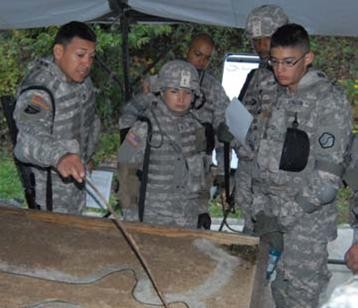
The 19th Expeditionary Sustainment Command Headquarters and Headquarters Company conducted a convoy live fire exercise at Warrior Base Story Live Fire Complex from Oct. 17-21. The intent was to train and build Soldiers' capability and confidence in tactical convoy missions through simulated battlefield conditions. The simulation consisted of five random scenarios which were intended to check the team's reaction, pro-activeness, and effectiveness in given situations. Capabilities on combat lifesaving, obstacle breaching, medical evacuation, squad automatic weapons firing, and vehicle recovery were challenged. According to Capt. Toney M. Brantley, 19th ESC HHC commander, the unit concentrated all its effort on this training for the last quarter. The 498th Combat Sustainment Support Battalion supported the CLFX from start to end as the training host. Observer controllers, trained and certified by the 498th, played an important role as safety controls throughout the exercise. Lt. Col. Ricardo Lebron, 498th CSSB commander, was the 19th ESC convoy team certifier. After spending the first day of the exercise practicing the expected scenarios at Warrior Base, the CLFX team traveled to the Story Live Fire Complex for training on the actual lane Oct. 19. Starting in the morning, the team was given a total of three chances to go through the course. The three iterations were dry, blank, and live fire run. Where the first two were chances for practice, the last was the subject for the final evaluation with live rounds. As the armed convoy, including three M1114 tactical vehicles and two light medium tactical vehicles drove the lane, they engaged pop-up targets assumed to be snipers, reacted to improvisedexplosive device attacks, treated a casualty, and conducted MEDEVAC. Each vehicle had one OC with three crew members consisting of a driver, track commander and a gunner, to observe safety during the exercise. Effective communication through the single channel ground and airborne radio system were essential to a flexible reaction. Vehicle noises, gun fire and limited vision for most team members made communication between them even more important. After each run, the team gathered for a thorough after action review, sharing thoughts for improving performance and reactions on the lane. Problems were identified and analysis was made with participation from each vehicle team. Experienced Soldiers came up with lots of ideas as they went through the iterations, such as using vehicle turn signals to indicate the direction of fire or designating the alternate litter carrying team in case the primary team is injured. As a result, the team was certified satisfactory by Lebron. "The exercise far exceeded my expectation," said Brantley. "I asked the commander how it went. He said, 'You know how it was,' with a smile." The team's quick reaction was proven excellent after the live fire run. "The live run went very well with the casualty carried by litter, secured and treated in a few seconds," said Sgt. John R. McCall, 19th ESC Training. "Our execution on the range was outstanding, and the team improved as they went through the iterations. The training throughout the last quarter helped the Soldiers feel more confident in warrior tasks and battle drills that are associated with convoy operations. And most of all, we conducted everything safely," said Brantley. The team had no accidents, injuries or damage to equipment from the start of the exercise through the MK-19 range in the end.

Social Sharing